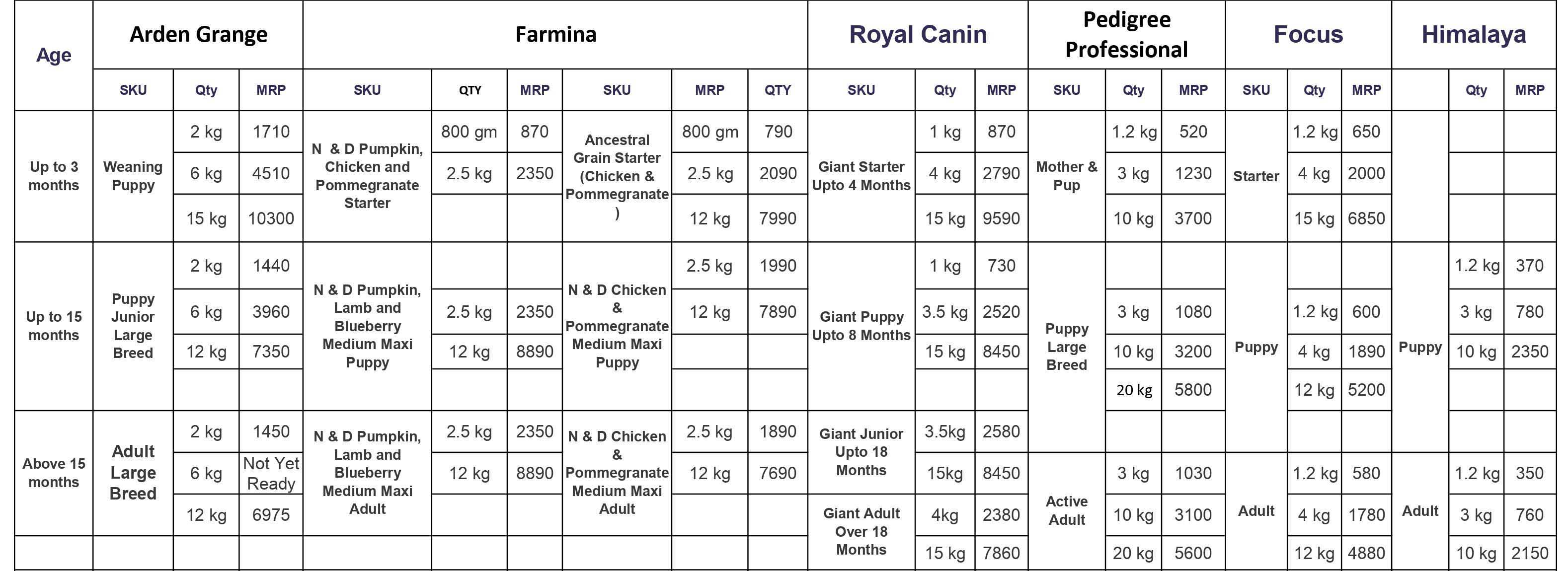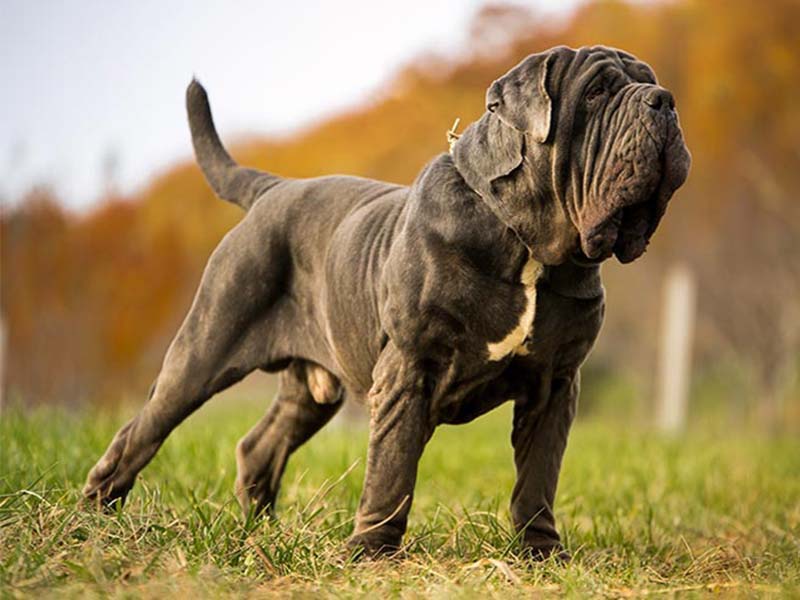Everything You Wanted To Know About Neapolitan Mastiff
Basic Information:
Life Expectancy: 8 - 10 years
Origin: Italy
Height: Male: 63-77 cm, Female: 58-70 cm
Colours: Black, Brindle, Tawny, Blue, Mahogany
Weight: Male: 60-70 kg, Female: 50-60 kg
Temperament: Stubborn, Obedient, Fearless, Dominant, Protective, Trainable
Dog Food Chart with MRP as on 19/10/2021 for Nepolitan Mastiff (Giant Breed) available in India:

Overview:
The Neapolitan Mastiff is a guardian breed from Italy. Characterized by his heavily wrinkled face, loose skin and imposing size, he has strong protective instincts and is a family companion or show dog. The Mastino, or Neo, as he is some nicknamed, is a giant breed, weighing 110 to 150 pounds or more.
The Neapolitan Mastiff has many good qualities, but he is not the easiest dog to live with. If you want the calm, confident dog that is the Neo at his best, be prepared to do a lot of homework to find him and put in plenty of effort training and socializing him once you bring him home.
While his protective nature, the Neapolitan Mastiff is not an appropriate choice for a novice dog owner. He needs someone who can guide him with kind, firm, consistent training, never force or cruelty. He is an independent thinker but responds well to routine.
The Neapolitan Mastiff has a low activity level, even as a puppy. A brief walk will give him the exercise he needs and would not stress his growing skeleton. Avoid taking him to dog parks since he may be aggressive toward dogs he does not know. He is best suited to a home with a large yard surrounded by a solid fence that is at least five or six feet high. This is a territorial breed, and he must learn his boundaries. Do not rely on an underground electronic fence to keep him contained. The shock it provides may not deter him from leaving the yard if that is what he wants to do.
Like any dog, Neapolitan Mastiff puppies are inveterate chewers and because of their size can do a whole lot of damage. Do not give them the run of the house until they have reached trustworthy maturity. And keep your Neapolitan Mastiff puppy busy with training, play and socialization experiences. A bored Neapolitan Mastiff is a destructive Neapolitan Mastiff.
Personality:
The Neo is quiet, watchful and protective of his family, including other pets. Although he may have the appearance of a gentle giant, he is not a mellow, easygoing dog. He is suspicious of strangers and can be aggressive toward dogs he does not know.
Because they bond so closely with their people, Neos may not like the intrusion of anyone else into the family circle.
Begin training as soon as you bring your Neapolitan Mastiff puppy home, while he is still at a manageable size. That 20-pound puppy will quickly grow much larger. A nothing-in-life-is-free program, requiring puppies to work for everything they get by performing a command before receiving meals, toys, treats or play, works well with this breed.
It is always a good idea to take a Neapolitan Mastiff to puppy kindergarten followed by a basic obedience class, especially if you are working with a trainer who understands the Neapolitan Mastiff mindset. Never wait until he is six months old to begin training, or you will have a more headstrong dog to deal with. If possible, get him to puppy kindergarten class by the time he is 10 to 12 weeks old, so you can start building a strong working relationship. Be aware that many puppy training classes require certain vaccines (like kennel cough) to be up to date, and many veterinarians recommend limited exposure to other dogs and public places until puppy vaccines (including rabies, distemper and parvovirus) have been completed. Instead of formal training, you can begin training your puppy at home and socializing with him among family and friends until puppy vaccines are completed.
Early, frequent socialization is essential to prevent a Neapolitan Mastiff from becoming overly suspicious or fearful of anything new or different. Purchase a Neapolitan Mastiff puppy from a breeder who raises the pups in the home and ensures that they are exposed to many different household sights and sounds, as well as people, before they go off to their new homes. Once your vet gives the green light, continue socializing your Neapolitan Mastiff throughout his life by taking him to puppy kindergarten class, visits to friends and neighbours, and selective outings to local shops and businesses. This is the only way he can learn to be discriminating, recognizing what is normal and what is truly a threat. These experiences as a young dog will help him grow into a sensible, calm adult dog.
Health:
All dogs have the potential to develop genetic health problems, just as all people have the potential to inherit a particular disease. Run, do not walk, from any breeder who does not offer a health guarantee on puppies, who tells you that the breed is 100 per cent healthy and has no known problems, or who tells you that her puppies are isolated from the main part of the household for health reasons. A reputable breeder will be honest and open about health problems in the breed and the incidence with which they occur in her lines.
The Neapolitan Mastiff has some health conditions that can be a concern. Neapolitan Mastiff has included orthopaedic problems such as hip and elbow dysplasia, eye problems such as cherry eye, entropion, ectropion and progressive retinal atrophy, a heart condition called Cardiomyopathy, and hypothyroidism. The breed may also be prone to gastric torsion (bloat) and cancer such as osteosarcoma.
Grooming:
The Neapolitan Mastiff has a short, dense coat with oily skin that has something of a musky odour. You may want to bathe your Neo regularly to keep the scent at bay. Brush or comb him daily to remove dead hair and keep the skin and coat healthy. Wipeout his wrinkles often with a damp cloth and dry them thoroughly to prevent skin fold infections.
The rest is basic care. Trim the nails as needed, usually once every few weeks. Brush the teeth frequently with a vet-approved pet toothpaste for good overall health and fresh breath. Check the ears weekly for dirt, redness or a bad odour that can indicate an infection. If the ears look dirty, wipe them out with a cotton ball dampened with a gentle, pH-balanced ear cleaner recommended by your veterinarian.
Published By: Admin
Published On: 9-October-2021

 0
0 










